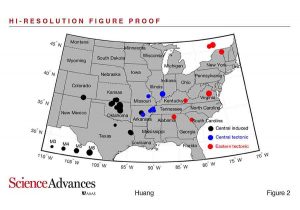
The stresses released by human-induced and naturally occurring earthquakes in the central United States are in many cases indistinguishable, meaning that existing tools to predict shaking damage can be applied to both types.
That’s the main conclusion of a study by a University of Michigan seismologist and two Stanford University colleagues, scheduled for online publication Aug. 2 in the journal Science Advances.
“Our study shows that induced earthquakes and natural earthquakes in the central U.S. are inherently similar, and we can predict the damaging effects of induced earthquakes using the same framework as natural earthquakes,” said Yihe Huang, first author of the Science Advances paper and an assistant professor in the U-M Department of Earth and Environmental Sciences.
“Our finding simplifies the task of hazard assessment because we don’t have to treat the shaking from these two kinds of earthquakes differently,” said co-author Gregory Beroza, co-director of Stanford’s Center for Induced and Triggered Seismicity.
Within the central and eastern U.S., the number of earthquakes has increased dramatically over the past few years. Wastewater disposal in deep wells, often associated with oil and natural gas extraction, is the primary cause of the recent increase in the central U.S., according to the U.S. Geological Survey.
In March, USGS concluded that about 3.5 million people live and work in areas of the central and eastern U.S. with significant potential for damaging shaking from human-caused earthquakes in 2017. Most of them live in Oklahoma and southern Kansas.
A key question is whether these so-called induced earthquakes excite ground motions that are substantially different than those of naturally occurring earthquakes. If that’s the case, then human-induced earthquakes could result in different levels and types of damage to buildings and infrastructure.
But if the ground motions in induced and natural earthquakes are largely the same, then equations used to predict damage from natural earthquakes can also be applied to human-induced quakes.
To answer this question, Huang and her colleagues used available instrumental recordings to estimate the stress drop—the difference between the stress across a fault before and after an earthquake—of 39 moderate-magnitude induced and natural earthquakes in the central U.S and in eastern North America.
They found that the stress drops of induced and natural earthquakes in the central U.S. are “indistinguishable” once the faulting mechanism and the depth of the quakes are accounted for. The finding suggests that ground motion prediction equations, known as GMPEs, used to predict damage from naturally occurring earthquakes can also be applied to induced quakes.
The results are also consistent with the idea that both naturally occurring and induced earthquakes are driven by stresses along geologic faults and that the injection of fluids in deep disposal wells advances the timing of induced earthquakes, triggering them.
The researchers analyzed natural and induced earthquakes with magnitudes between 3.8 and 5.8 in the central U.S. and eastern North America, comprising three populations.
They looked at naturally occurring earthquakes in and around the New Madrid and Wabash Valley seismic zones in the central U.S., as well as induced earthquakes occurring further to the west but east of the Rocky Mountains, mainly in Oklahoma and southern Kansas.
In the central U.S., more than half of the induced earthquakes were shallower than 5 kilometers (3.1 miles), while all of the naturally occurring earthquakes were deeper than 5 kilometers.
In eastern North America, they studied naturally occurring U.S. and Canadian earthquakes around and to the east of the Appalachian Mountains.
“We found that naturally occurring earthquakes in the east may lead to stronger shaking than natural earthquakes in the central U.S., differences that may be due in part to fault type,” said co-author William Ellsworth, co-director of Stanford’s Center for Induced and Triggered Seismicity.
Most eastern earthquakes occur on reverse faults, while most central U.S. induced and natural earthquakes occur on strike-slip faults. Reverse-faulting earthquakes typically have stronger shaking than strike-slip earthquakes.
Between 1980 and 2000, Oklahoma averaged about two earthquakes greater than or equal to magnitude 2.7 per year, according to the U.S. Geological Survey. That number jumped to about 2,500 in 2014 and 4,000 in 2015, then dropped to 2,500 in 2016, according to USGS. On Sept. 3, 2016, a magnitude-5.8 earthquake struck Oklahoma, the state’s largest earthquake to date.
According to USGS, many earthquakes in Oklahoma and other parts of the central U.S. have been triggered by wastewater fluid injection associated with oil and gas operations. In some cases, wastewater disposal in deep wells is associated with hydraulic fracturing sites. However, studies suggest that the fracking process itself is rarely the direct cause of these earthquakes.
Reference:
“Stress drops of induced and tectonic earthquakes in the central United States are indistinguishable” Science Advances (2017). DOI: 10.1126/sciadv.1700772
Note: The above post is reprinted from materials provided by University of Michigan.










